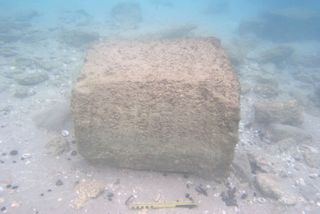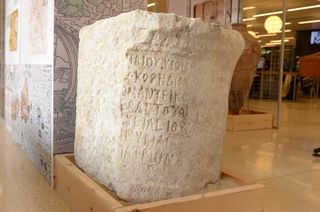
A stone slab found off the coast of Israel has finally revealed the name of the ruler during one of the most iconic moments in Jewish history: the Bar Kokhba revolt.
The slab dates to the second century A.D., a bloody time in Jewish history when a fiery leader named Simon bar Kokhba led a failed revolt against Roman rulers. The huge chunk of stone was found at an underwater site called Tel Dor, located about 18 miles (30 kilometers) south of the city of Haifa. [Photos: 5,000-Year-Old Stone Monument in Israel]
The area once housed the Biblical city of Dor, which was occupied until the fourth century. Over the last 70 years, the site has yielded a treasure trove of pottery, anchors and other artifacts from ancient Israel. Ehud Arkin-Shalev and Michelle Kreiser, researchers from the Coastal Archaeology Laboratory at the University of Haifa, uncovered the giant slab while looking in the water of the Dor Nature Reserve.
The inscription was clearly visible, even beneath the water, the researchers said. The team eventually decided to bring the slab out of the water, to prevent damage to the inscription. Researchers discovered that the massive, 1,300-lb. (600 kilograms) slab had seven lines of ancient Greek inscribed upon it.

"The stone probably formed the base of a sculpture from the Roman period. As far as we know, this is the longest inscription found underwater in Israel," Assaf Yasur-Landau, the University of Haifa archaeologist who led the excavation, said in a statement.
Although the researchers have not completely deciphered the text, they have already made two discoveries: The inscription identified the Roman prefect in charge of Judea as Gargilius Antiques. Though researchers had found one other inscription bearing this name, that artifact did not mention the region Antiques ruled. In addition, the inscription confirms the name of the province involved in the revolt as Judea, which, until now, no inscription immediately preceding the Bar Kokhba revolt had stated, the researchers said.
The inscription dates from a tumultuous time in Jewish history. The second temple was destroyed in A.D. 70, and around A.D. 132, tensions simmering between the Roman rulers of the province and the Jewish inhabitants boiled over once again. At that point, the Jewish leader Simon bar Kokhba led a revolt against the Romans. During the four years of fighting, both sides sustained heavy casualties, and many Jews were ultimately sold into slavery or scattered.
Sign up for the Live Science daily newsletter now
Get the world’s most fascinating discoveries delivered straight to your inbox.
"Immediately after the Bar Kokhba revolt, the Romans decided to abolish the province of Judea and to obliterate any mention of its name. The province was united with Syria to form a single province called Syria-Palestine," Yasur-Landau said. "So what we have here is an inscription dated to just before Judea ceased to exist as a province under that name. Of the two inscriptions mentioning the name Judea, this is the latest, of course. Because such findings are so rare, it is unlikely that we will find many later inscriptions including the name Judea,"
Original article on Live Science.

Tia is the managing editor and was previously a senior writer for Live Science. Her work has appeared in Scientific American, Wired.com and other outlets. She holds a master's degree in bioengineering from the University of Washington, a graduate certificate in science writing from UC Santa Cruz and a bachelor's degree in mechanical engineering from the University of Texas at Austin. Tia was part of a team at the Milwaukee Journal Sentinel that published the Empty Cradles series on preterm births, which won multiple awards, including the 2012 Casey Medal for Meritorious Journalism.
Most Popular


